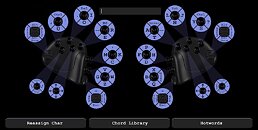Sunday, January 12th 2020

CharaChorder Aims to Enable Typing at the Speed of Thought, Shows off Prototype at CES
Attending CES is a mixed bag even before you arrive there, and it comes in the form of about a billion marketing emails invading your inbox. Amidst all these, however, was one from this US-based startup company that interested me in more ways than one. Perhaps because I handle keyboard duties here on TechPowerUp, among other things, but I have always been fascinated with products aiming to enable a more ergonomic and efficient typing experience. These products tend to take the form of smaller form factor, split or otherwise, keyboards that still adopt the staggered columns of keys. Layers are the name of the game here, with customization in the form of key mapping enabling people to position keyboards with a combination of tent, tilt, and height adjustments- especially for split keyboards. But all these still rely on the end user typing on, say, a QWERTY layout with 2-4 fingers simultaneously nearly every single time. CharaChorder wants to rethink the keyboard, and offer a product that helps you type with all 10 fingers.
The company sought inspiration from the humble stenograph, as well as arguably more efficient typing layouts such as Dvorak over QWERTY, and had a prototype for demo at CES that showcased their "3-dimensional" typing via sticks that can be assigned to a different function for each axis. I admittedly was skeptical with the emails, as well as the rough plastic casing they initially showed, but then they pulled out the working PCBs as part of the two connected halves, and typed my name and affiliation on a connected laptop at ~200 WPM. There were also only two errors throughout, which is impressive given these were words and sentences they had no way to practice before, and the speed comes in the form of them having practiced ~30-60 min a day for a month in "chorded" mode which allows simultaneous presses instead of one character at a time, which is the recommended training schedule for new users. The CharaChorder is also ambidextrous enabling users to quickly use this alongside a mouse, or even a joystick, with applications ranging from typing, to gaming via macros, and more. The company has the product up for pre-order already for $199.99 with expected delivery in December 2020 provided they hit their funding goals. Check out their website, as well as this demo video, to get a better idea of how the product works.
The company sought inspiration from the humble stenograph, as well as arguably more efficient typing layouts such as Dvorak over QWERTY, and had a prototype for demo at CES that showcased their "3-dimensional" typing via sticks that can be assigned to a different function for each axis. I admittedly was skeptical with the emails, as well as the rough plastic casing they initially showed, but then they pulled out the working PCBs as part of the two connected halves, and typed my name and affiliation on a connected laptop at ~200 WPM. There were also only two errors throughout, which is impressive given these were words and sentences they had no way to practice before, and the speed comes in the form of them having practiced ~30-60 min a day for a month in "chorded" mode which allows simultaneous presses instead of one character at a time, which is the recommended training schedule for new users. The CharaChorder is also ambidextrous enabling users to quickly use this alongside a mouse, or even a joystick, with applications ranging from typing, to gaming via macros, and more. The company has the product up for pre-order already for $199.99 with expected delivery in December 2020 provided they hit their funding goals. Check out their website, as well as this demo video, to get a better idea of how the product works.



14 Comments on CharaChorder Aims to Enable Typing at the Speed of Thought, Shows off Prototype at CES
If you've ever seen someone type traditional Chinese, you know this isn't going to work for that as an example.
It also looks like something designed for an alien.
Gaming is the other thing... joystics are better at that.
It is a very niche thing. The market for this thing is questioniong the economic reason funding such product.
edit ... [/sarcasme] (obviously that keyboard wouldn't work with me ... )
Note that most keyboard layouts outside the US substitutes the right "Alt" key for a "AltGr" (same function as "Alt" + "Ctrl") to get more characters on the same keyboard.
as for normal letters in a alphabet:
Spanish has 27 letters
Scandinavian has 29 letters
German has 30 letters
Russian has 33 letters
to name a few
This is the layout in Taiwan for example. Three characters plus per letter key, not counting the regular roman alphabet.
Japanese is a bit similar too.